Intel Core 2 CULV Roundup: Who Needs Atom?
by Jarred Walton on February 4, 2010 4:00 AM ESTBlending Battery Life with Performance
We just showed how CULV skunks Atom when it comes to performance. Dual-core Atom 330 is still quite a bit slower, and it's not even close when we look at the mobile Atom CPUs. This is all from a relatively "weak" 1.3GHz Core 2 processor. But Atom CPUs have a TDP of just 2.5W for N280 and 5.5W for N450 (the latter also includes the chipset, so it actually uses less power than N280 + 945GSE); meanwhile, CULV is listed as having a TDP of 10W. Advantage: Atom, right? Well, not so fast. The newer Pine Trail platform definitely helps, with a much lower power draw from the chipset and graphics. Max TDP doesn't necessarily correlate well to idle or low use TDP, though, which is where most users tend to operate their PCs. Here's how battery life stacks up.
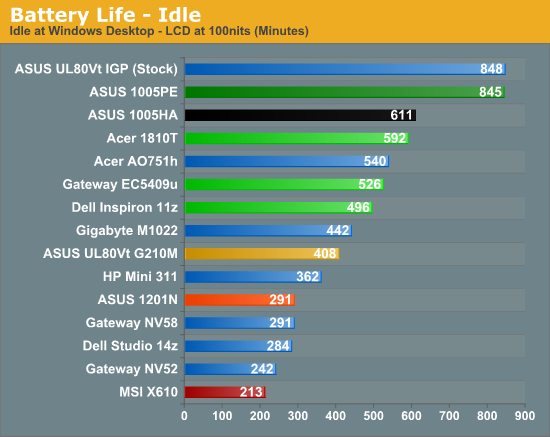
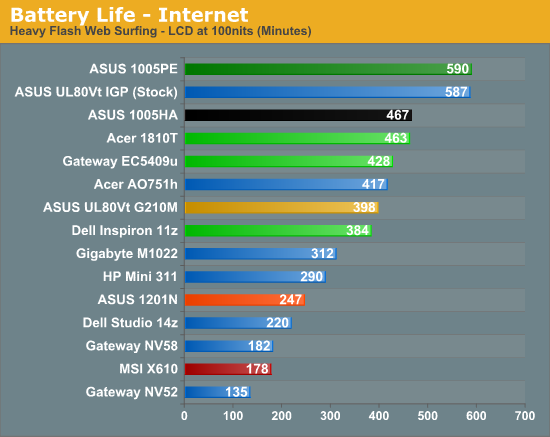
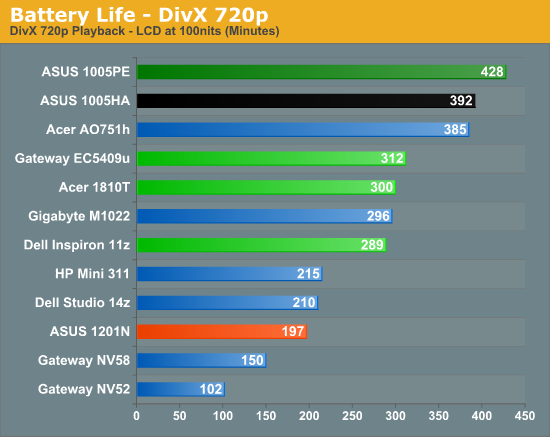
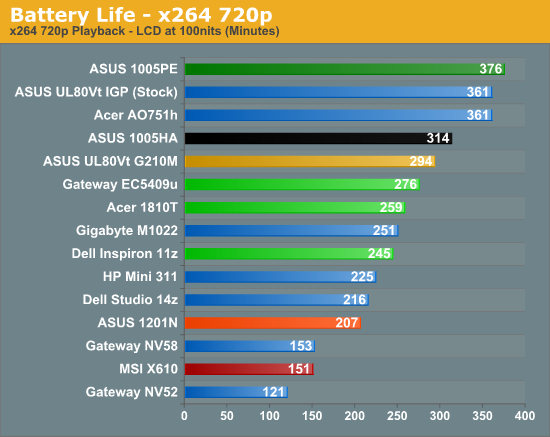
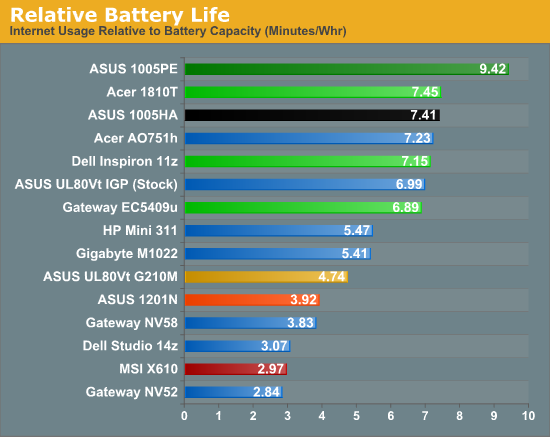
We gained performance but we do give up a bit in battery life - at least when we look at Pine Trail. The smaller CULV laptops like the Acer AS1810T are able to come very close to Atom N280 battery life in the Idle and Internet tests, while the video playback results still favor N280 (provided you're not trying to do 1080p H.264). Atom N450 on the other hand manages to boost battery life by anywhere from 10% (DivX) to 40% (Idle), putting it out of reach of CULV when both are using similar capacity batteries.
The AS1810T delivers an impressive result in our Heavy Internet Browsing test, coming in just shy of eight hours at 463 minutes. That's a virtual tie with the older Atom N280 based ASUS 1005HA (467 minutes), indicating CULV is able to render the web pages and get to a deep sleep state faster than N280. The newer ASUS 1005PE Pine Trail netbook still bests the AS1810T by just over two hours (590 minutes), so if you want maximum battery life Atom continues to beat the other Intel processors. The other CULV options both trail the AS1810T, which is expected. The EC5409u is larger and so the LCD will draw more power, while the Dell 11z has a slightly lower capacity battery.
In terms of relative battery life (and of course, we should note that we're going off the advertised battery capacities, which may be slightly off), the CULV and most N280 offerings are clustered tightly together. While the EC5409u does use more power, the DDR3 memory appears to mitigate that somewhat, with overall battery life still very close to the smaller laptops. Pine Trail is at its best in Idle battery life, but the Internet test is another strong point: it gets 25% more battery life compared to CULV for the same battery capacity.
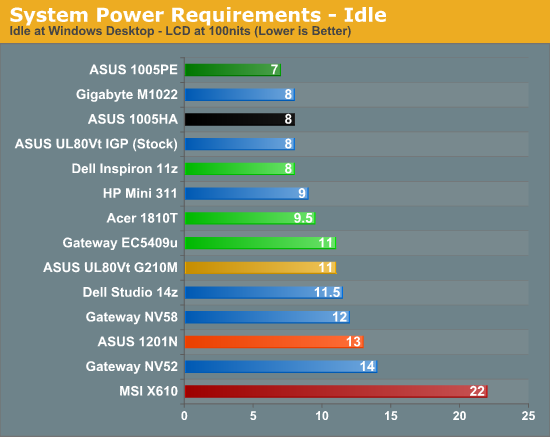
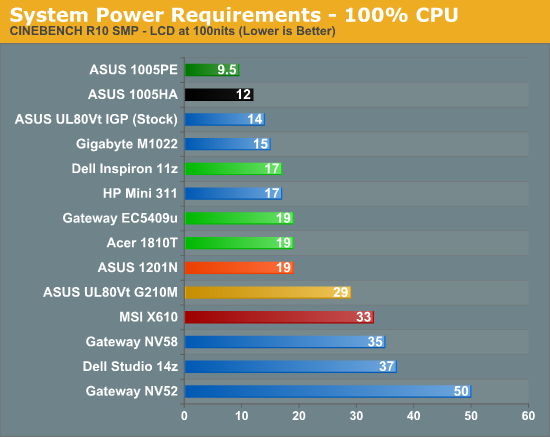
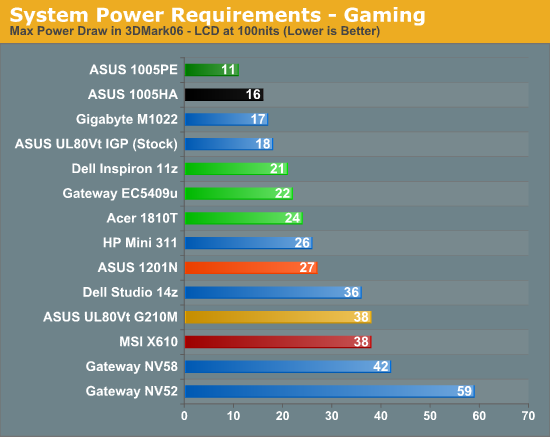
Looking at power requirements helps clear up any lingering questions. Mobile Atom CPUs are designed to sip power, with their highest load sucking down around 4W for N450 and 7W for N280 (including chipset power draw). We estimate that at idle, Atom N280 uses 1W, the chipset probably uses 2W, LCD gets 3W, and the remainder is divvied up among the other bits and pieces. Atom N450 can cut another 1W from Idle power requirements, which is at least a 15% reduction (and possibly more, given our tools are only accurate to at best .5W). In contrast, a CULV CPU can idle very well, but under load the power draw jumps significantly. The AS1810T looks like it uses every bit of its 10W max TDP. Add on graphics and the gap widens even more, though here we need to mention that GMA 950/3150 are a very big step down from GMA 4500MHD (which is another big step back from something like GeForce 9400M).
Overall, it appears that CULV processors are very similar in terms of idle power requirements when compared to Atom N280, especially once we factor in chipsets. As we mentioned above, in many situations an application will need to do a set amount of work as quickly as possible (e.g. rendering a web page), after which the CPU can go into a deep sleep state. The faster the work gets done, the sooner the CPU can sleep, and the net result is that even in moderate loads CULV can compete quite well against N280. The catch is that there are other loads (like video decoding) where CULV ends up using quite a bit more power than Atom, but in common usage scenarios the battery life is still very good.










62 Comments
View All Comments
diego10arg - Monday, March 15, 2010 - link
Hi all,I am trying to upgrade my Atom 270N netbook and my primary and only concern is FullHD Playback through HDMI. I will be using an external harddrive for backup and storage purposes, so HD does not matter.
After looking for a while I found several laptops with Celeron ULV 723, Athlon Neo MV-40, SU4100 and SU7300.
So far I got this prices (I live in Argentina, prices are in USD)
. MSI Wind 210-050AR, Athlon Neo MV-40, 2GB RAM, HD250Gb > 609 USD
. MSI X340-241AR, Celeron ULV 723 1.2Ghz, 2GB RAM, HD320Gb > 699 USD
. Dell Inspiron 11z, ULV SU4100, 2Gb RAM, HD160Gb > 709 USD
. ASUS AU UL30A-QX050D, ULV SU7300, 4Gb RAM, HD320GB > 915 USD
What differences are between CULV 723 and SU4100?
What would you buy? Why?
Thanks all!
Regards,
DiEGO
Daeros - Monday, March 1, 2010 - link
Any word on how something like the 1201n will perform with the new GPU-accelerated versions of Firefox and IE? I feel the current-gen Intel graphics are just unacceptable, so the Ion and AMD laptops are more attractive, but I don't want to feel like I'm trapped in molasses when I browse the interwebs.fwacct4 - Monday, February 15, 2010 - link
I would like to see noise levels tested for laptops. The thing with desktops is that you can actually hide them some place where noise doesn't bother people, but laptops are always right in front of you, and some laptops have a very annoying high-pitch noise that is noticeable because they are so close to the user.I'm sure there are a lot of people interested in having quiet laptops, so I hope that noise level can be compared among laptops as well, and especially with CULV processors which are low voltage, there is an opportunity to present a particular model as being particularly quiet, which would really be a selling point for some.
JarredWalton - Tuesday, February 16, 2010 - link
All of the CULV laptops tend to run very quiet, to the point where my SPL meter has trouble detecting the noise level over the background noise in the room (around 30dB). Even under a heavy stress test like CINEBENCH, the fans rarely reach a level that I would consider distracting (so typically under 35dB). When you're not running a stress test, the fans are often stopped. Out of the three, the Gateway EC5409u seems to be a bit quieter, likely because it's larger and has even more room inside to dissipate heat, but the others weren't loud by any stretch.viewwin - Tuesday, February 9, 2010 - link
I would like to see the next version of Ion mixed with a CULV CPU for a decently powerful HTPC.acron1 - Tuesday, February 9, 2010 - link
A couple of weeks ago I was looking to replace my Toshiba NB205 with something small but with a bit more punch. I ended up with the Toshiba Satellite T115D-S1125 primarily because of the HD3200 graphics. I knew that in terms of battery life the Intel based solutions are better choices but I wanted the extra graphics power available from ATI. Battery life while browsing the web, some flash and email is just over 5 hours...Hrel - Saturday, February 6, 2010 - link
I'm still waiting for a CULV laptop with a screen of AT LEAST 1600x900 and a dedicated GPU that's about equivalent to the GT240 from Nvidia; I'd prefer it be from Nvidia but since I want DX11 AMD will do fine; the 5series really steps it up. Asus has what I agree is the best CULV laptop, I just want the CPU overclocked to 2GHz, a screen with a resolution of 1600x900 and a GPU about as powerful as a GT240 for 1000 bucks or less. That's totally reasonable. And I want it NOW! 15" chassis too, btw.Schugy - Friday, February 5, 2010 - link
I don't think that I care about the time I can wait in front of my Netbook but I need to know whether the battery can encode xxx thousand frames to complete the task.JarredWalton - Friday, February 5, 2010 - link
In that case, FPS is a more useful figure than the time taken, since you don't know how many frames are in the video we choose to test. (For reference, we use a 1080p MPEG2 video for the DivX test with 719 frames.) You would also need to know how long the battery lasts under a heavier CPU load, which I haven't shown here. If you look at the "100% CPU power draw" figure and divide the battery capacity by that amount, you can get an estimate... but the power settings will definitely come into play.Let's see if I can help: a 90 minute DVD as an example encoded into DivX would require the encoding of approximately 162000 frames. Now our test results show 5.14 FPS, but that's a far more complex 1080p encode. DVD quality should be a lot faster. A quick test of a 3978 frame chapter of a DVD yields an encode rate of 43.71 FPS (91.0 seconds) on the Gateway EC5409u. That means for a 90 minute 30 FPS DVD (like my test video), you'd need at least 61.77 minutes of battery life. I don't even need to run a test to say that it wouldn't be a problem for CULV on that sort of encode. Atom N450 would still take about 40~50% longer, but again that's not a problem.
Then again, the default settings result in a low quality encode. If you do a 2-pass DivX encode targeting better quality, total time required increases over two-fold. I just tried it out and the EC5409u managed to encode the same 3987 frame DVD chapter in 237s, or 16.83 FPS. That means roughly 2.7 hours for a 90 minute DVD, or over 3.5 hours for a two hour DVD encode. If that's what you're trying to do, it's unlikely you'll manage the entire encode while on battery.
buzznut - Thursday, February 4, 2010 - link
I have the 8200M chipset, I really wouldn't recommend it for gaming. As the article suggests, a discrete graphics option would be better. I think the chipsets that allow the discrete card to turn off when not needed to save battery life are the best options.My laptop has a 2.1 Ghz dual core and 4 gigs of ram, with 4 gigs ready boost. It can't game very well, its heavy and the battery life is atrocious. It gets quite hot while watching video, probably the cpu while using flash, and struggles with hidef.
Given today's options, I would not have gone with the notebook I currently have, as it is too big to carry with the addition of my enormous and heavy chem and bio books. Why drag it along when the battery will die after 2 hours? Most days it sits on a bed side table. I think I would go for a culv with the switchable chipset I mentioned. I am quite jealous of my wife's netbook and 8 hour battery life.
Nice article, it would be nice to visit again in 6 months to see how the mobile market changes.